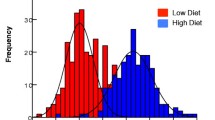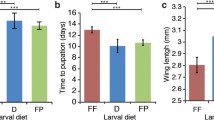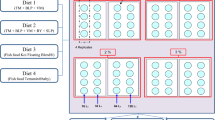Abstract
The influence of larval diet, body weight at imago, size of blood-meal and age on the fecundity of Culex quinquefasciatus was investigated. The mean weights of mosquitoes at adult.emergence varied significantly with larval diet. Larvae reared on liver diet grew into heavier adults, and produced more eggs than those reared on milk. The volume of blood engorged by the female mosquitoes apparently remains constant during each gonotrophic cycle. However, the number of eggs produced is a function of both the blood-meal size and age of the mosquitoes. These results were discussed in relation to the need for full knowledge of the reproductive potential of this species of filaria vectors.
Résumé
L’influence due régime larvaire, du poids (du corps) à imago, de la quantité due sang sucé et de l’âge sur la fécondité de Culex quinquefasciatus a été étudiée. Le poids moyen des moustiques quand ils émergent à l’âge adulte varie considérablement selon le régime larvaire. Les larves élevées sur un régime de foie sont devenues des adultes pesant plus lourd et produisant un nombre plus élevé d’oeufs que celles élevées sur un régime de lait. Le volume de sang englouti par les femelles demeure apparemment inchangé tout le long de chaque cycle gonotrophique. Cependant, le nombre d’oeufs produit dépend non seulement de la quantité due sang sucé mais aussi de l’âge physiologique des moustiques. Ces résultats ont été examinés par rapport à la nécessité d’avoir une connaissance plus complète due potentiel réproductif de cette espèce de vecteurs filaires.
Similar content being viewed by others
References
Abdelnur O. M. (1968) The biology of some blackflies (Diptera: Simulidae) of Alberta. Quaest. Entomol. 4, 113–174.
Bellamyr E. and Bracken G. K. (1971) Quantitative aspects of ovarian development in mosquitoes. Can. J. Entomol. 103, 763–773.
Chutter F. M. (1970) A preliminary study of factors influencing the number of oocytes present in newly emerged blackflies (Diptera: Simulidae) in Ontario. Can. J. Zool. 48, 1389–1400.
Clements A. N. (1963) The Physiology of Mosquitoes. Pergamon Press, London.
Colless D. H. and Chellapah W. T. (1960) Effects of body weight and size of bloodmeal upon egg production in Aedes aegypti (Linnaeus) (Diptera: Culicidae). Ann. Trop. Med. Parasitol. 54, 47.
Edman J. D. and Lynn H. (1975) Relationship between bloodmeal volume and ovarian development in Culex nigripalpus (Diptera: Culicidae). Entomol. Exp. Appl. 18, 492–496.
Gillett J. D. (1956) Initiation and promotion of ovarian development in the mosquito Aedes (Stegomyia) aegypti (Linnaeus). Ann. Trop. Med. Parasitol. 50, 375.
Johannson A. S. (1964) Feeding and nutrition in reproductive processes in insects. In Insect Reproduction (Edited by Higam K. C). Symp. R. Entomol. Soc. London, pp. 43–55.
Larsen J. R. and Bodenstein D. (1959) The humoral control of egg maturation in the mosquito. J. exp. Zool. 140, 343.
Lavoipierre M. M. J. (1961) Bloodfeeding, fecundity and ageing in Aedes aegypti var. queenslandensi. Nature 191, 571–576.
McDonald W. W. (1956) Aedes aegypti in Malaya — II. Larval and adult biology. Ann. Trop. Med. Parasitol. 50, 399.
Mathis M. (1938) Influence de la nutrition larvaire sur la fecundité du stegomyia (Aedes aegypti L.). Bull. Soc, Path. Exot. 311, 640.
Mokry J. E. (1980) A method for estimating the age of field collected S. damnosum s.l. Theobald (Diptera: Simulidae). Tropen. Med. Parasitol. 31, 121–127.
Roy D. N. (1936) On the role of blood in ovulation in Aedes aegypti Linn. Bull. Entomol. Res. 27, 423–429.
Shelton R. M. (1972) The effect of blood source and quantity on production of eggs by Culex salinarius Coquillett (Diptera: Culicidae). Mosquito News 32, 31–37.
Subra R. (1971) Etudes écologique sur Culex pipiens fatigans Wiedemann, 1828 (Diptera, Culicidae) dans une zone urbaine de savane soudanienne ouest africaine. Dynamique des populations preimaginales. Cah. ORSTOM., Ser. Entomol. Med. Parāsit. 9, 73–102.
Subra R. (1973) Etudes écologique sur Culex pipiens fatigans Wiedemann, 1828 (Diptera, Culicidae) dans une zone urbaine de savanne soudanienne ouest africaine. Dynamique des populations preimaginales. Cah. OR STOM., Ser. Entomol. Med. Parasit. 11, 19–100.
Twohy D. W. and Rozeboom L. E. (1957) A comparison of food reserves in autogenous and anautogenous Culex pipiens populations. Am. J. Hygiene 65, 316.
Woke P. A., Ally M. S. and Rosenberger C. R. (1956) The numbers of eggs developed, relate to the quantities of human blood ingested in Aedes aegypti (L.). Ann. Entomol. Soc. Am. 49, 435.
Author information
Authors and Affiliations
Rights and permissions
About this article
Cite this article
Akoh, J.I., Aigbodion, F.I. & Kumbak, D. Studies on the Effect of Larval Diet, Adult Body Weight, Size of Blood-Meal and Age on the Fecundity of Culex Quinquefasciatus (Diptera: Culicidae). Int J Trop Insect Sci 13, 177–181 (1992). https://doi.org/10.1017/S1742758400014326
Received:
Revised:
Published:
Issue Date:
DOI: https://doi.org/10.1017/S1742758400014326




